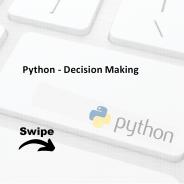Topic: Decision Making - PowerPoint PPT Presentation
1 / 27
Title:
Topic: Decision Making
Description:
Decision Making: Biases and Heuristics ... manufacturer, recently hired a former Olympic cross-country skier to test its products. ... – PowerPoint PPT presentation
Number of Views:184
Avg rating:3.0/5.0
Title: Topic: Decision Making
1
Topic Decision Making
2
Decision Making
- 2 Primary Approaches
- Classical Decision Theory (CDT)
- Behavioral Decision Theory (BDT)
3
Classical Decision Theory (CDT)
- The Optimizing model
- Problems are carefully defined
- Alternatives are systematically generated and
evaluated - Solutions are carefully chosen to optimize
outcome
4
Behavioral Decision Theory
- The Satisficing Model
- Bounded Rationality
- Use obvious choices
- Confine search to similar solutions
- Incremental changes
- Sequential order of comparisons
- Satisficechoose one that fits
5
BDT Assumptions
- Individuals have limited cognitive capacity
- Ability to make rational decisions bounded by
cognitive limitations
6
Which is accurate (in describing what we do)?
- BDT more than CDT, but . . .
7
Type of Decision
- Programmed (Routine)
- About 90 of all decisions
- Non-programmed (Unique)
- About 10
- With Non-programmed QUASI-optimizing
- Cognitive limitations, but more systematic
approach, search, and evaluation
8
Decision Making Biases and Heuristics
- Theres more going on than just rational vs.
nonrational...
9
Decision Making Quiz
10
Q1 Which of the following causes more deaths in
the US each year?
- A) pneumonia
- B) motor vehicle accidents
11
Decision Making Biases and Heuristics
- Availability
12
Q2 Mark is finishing his MBA at a prestigious
university. He is very interested in the arts
and at one time considered a career as a
musician. Is Mark more likely to take a job
- A) In the management of the arts?
- B) With a management consulting firm?
13
Decision Making Biases and Heuristics
- Representativeness
14
Q3 A certain town is served by two hospitals.
In the larger hospital about 45 babies are born
each day and in the smaller hospital about 15
babies are born each day. As you know, about 50
percent of all babies are boys. However, the
exact percentage varies from day to day.
Sometimes it may be higher than 50 percent,
sometimes lower. For a period of one year,
each hospital recorded the days in which more
than 60 percent of the babies born were boys.
Which hospital do you think recorded more such
days? The larger hospital?
The smaller hospital? About the
same? (that is, within 5 percent of each other)
15
Q5 The North Face, a mountaineering equipment
manufacturer, recently hired a former Olympic
cross-country skier to test its products. What
is your teams (average) estimate for salary?
- 25,000
- 40,000
- 60,000
- 125,000
- 150,000
- 175,000
16
- Q5 The North Face, a mountaineering equipment
manufacturer, recently hired a former Olympic
cross-country skier to test its products. What
is your teams (average) estimate for salary?
200
180
160
140
120
100
80
60
40
20
0
T1
T4
T3
T6
T2
T5
17
Decision Making Biases and Heuristics
- Anchoring and adjustment
18
Q5 Which of the following appears most likely?
Which appears second most likely?
- Drawing a red marble from a bag containing 50
percent red marbles and 50 percent white marbles. - Drawing a red marble seven times in succession,
with replacement (a selected marble is put back
into the bag before the next marble is selected),
from a bag containing 90 percent red marbles and
10 percent white marbles. - Drawing at least one red marble in seven tries,
with replacement, from a bag containing 10
percent red marbles and 90 percent white marbles.
19
Conjunctive and Disjunctive events
20
Listed below are 10 uncertain quantities. For
each, write down your best estimate. Next, put a
lower and upper bound around your estimate so
that you are 98 confident that your range
surrounds the actual quantity
- a.
- b.
- c.
- d.
- e.
- f.
- g.
- h.
- i.
- j.
21
To reiterate Biases and heuristics
- Availability
- Representativeness
- Anchoring and adjustment
22
Wait, but theres more!
- The confirmation trap
- Hindsight bias
23
Card 3 Outcome Rise in the market
Card 2 Prediction Unfavorable Report
Card 4 Outcome Fall in the market
Card 1 Prediction Favorable Report
24
Hindsight
- How likely was it that the Indianapolis Colts
would beat the spread in the Super Bowl?
25
What to do about heuristics and biases?
- Overall, heuristics are useful!
- But . . . Not always.
- The key is to recognize
- That they exist (and they are our default!)
- That they affect our decision process
- When its appropriate and inappropriate to use
them - How to overcome theme.g., actively seek more
complete information
26
How can you improve decision making?
- Acquire experience and expertise
- De-bias judgments
- Recognize possibility of bias
- Recognize the direction of the bias
- Seek feedback
- Training in decision making
- Learn to adjust intuitive estimates
- Expert systems
27
Attributes of a quality decision process
- Consideration of multiple alternatives
- Identification and discussion of merits and
underlying assumptions (watch out for biases) - Specifying desired outcomes prior to considering
alternatives - Debate and substantive conflict
- Perceptions of fairness participation































